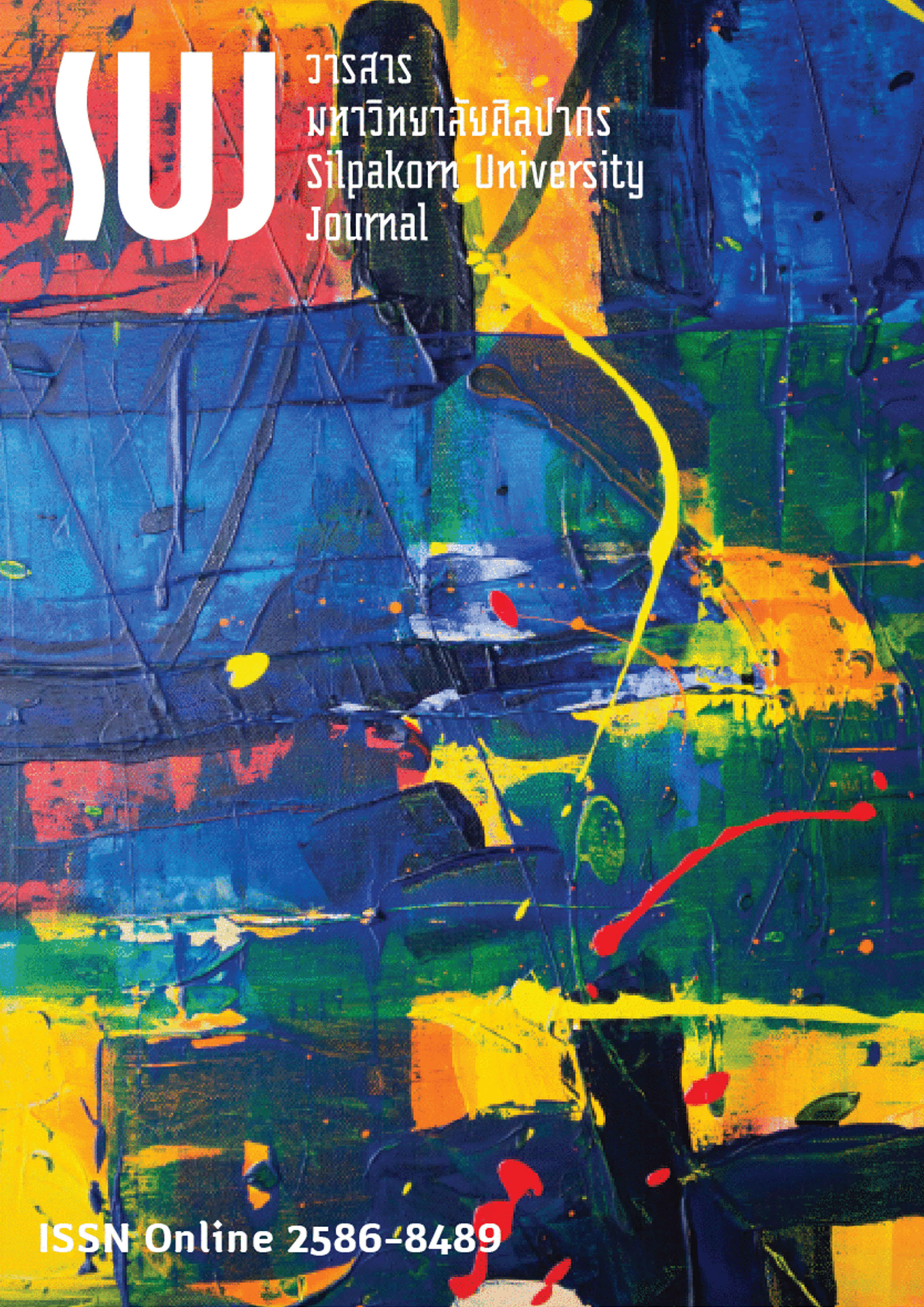ธรรมาสน์ในภาพแทนของจักรวาลวิทยาสู่การออกแบบพื้นที่ร่วมสมัย (The pulpit as a representation of cosmology to contemporary space design)
Main Article Content
Abstract
การศึกษาศิลปกรรมธรรมาสน์ในประเทศไทยนั้น แต่เดิมเป็นลักษณะของการอธิบายและรวบรวมทางด้านรูปแบบที่ปรากฏตามลักษณะความงามในศิลปะแบบไทยประเพณี หากแต่ผู้ศึกษามีวัตถุประสงค์ต้องการที่จะวิเคราะห์ความหมาย สัญลักษณ์ และคติความเชื่อเกี่ยวกับการสร้างสรรค์ศิลปกรรมธรรมาสน์ในยุคโบราณ จากข้อสันนิษฐานถึงความเกี่ยวข้องกับคติความเชื่อเรื่องไตรภูมิหรือจักรวาลวิทยา ที่ส่งผลต่อการกำหนดการออกแบบ และการถ่ายทอดเป็นการออกแบบ ทั้งความหมาย และการใช้งาน ด้วยการเก็บตัวอย่างจากการสำรวจศิลปกรรมธรรมาสน์ในหลายแห่งและเปรียบเทียบกัน รวมถึงองค์ประกอบที่เกี่ยวข้อง สามารถแสดงให้เห็นความหมายที่ซ่อนอยู่ในการออกแบบและการสร้างสรรค์ศิลปกรรมธรรมาสน์ จากการค้นคว้าพบว่า คติความเชื่อทางจักรวาลวิทยาเป็นแนวทางสำคัญหลักให้เกิดรูปแบบที่ปรากฏ แสดงระดับฐานานุศักดิ์ และยังผสมผสานกับระบบความเชื่อในกลุ่มชนหรือวัฒนธรรมเฉพาะทำให้เกิดความหลากหลายตามแนวคิดที่ปรากฏ การสร้างสรรค์ศิลปกรรมธรรมาสน์ในภาพแทนของจักรวาลวิทยาแบบเดิม อาจไม่สอดคล้องกับยุคสมัยที่เปลี่ยนไป เนื่องจากการมีเทคโนโลยีทดแทน การถูกท้าทาย รวมทั้งการอธิบายโลกและจักรวาลได้ตามหลักวิทยาศาสตร์ ปรัชญาหรือค่านิยมความเท่าเทียมกันในสังคม จึงเป็นเหตุให้การใช้และการสร้างสรรค์ศิลปกรรมธรรมาสน์ไม่เป็นที่นิยม แต่องค์ความรู้จากภูมิปัญญาของศิลปกรรมสามารถนำมาต่อยอดให้เหมาะสมกับแนวคิดและสอดคล้องกับสังคมสมัยปัจจุบันที่ต้องการพื้นที่ร่วมสมัย ลดคตินิยมในพื้นที่การแสดงธรรมในรูปแบบเดิม สู่การแสดงออกอย่างสาธารณะในพื้นที่ร่วมสมัยมากขึ้น
The study of the art history of pulpit design in Thailand originally focused only upon the beauty of Thai traditional art. Despite that, the objectives of this research are different. This study was aimed at analyzing the meaning, symbols, and beliefs in relation to the creations of Thai traditional pulpit designs from the ancient times. The assumptions of this study are that the traditional designs of pulpits were influenced by the belief in Tribhum or cosmology, both in terms of meanings of designs and functionality of pulpits. The data of this research were collected from selected pulpits, then the data were compared and analyzed to untangle hidden meanings in the design and to identify beliefs behind the art of pulpit creation. The findings showed that cosmological beliefs are the main guidelines to design the pulpits. Those designs are suggestive of the rank orders of the preachers who use them. Also, when the cosmological beliefs are intermingled with local or cultural beliefs of a specific group, it results in a variety of art and designs. Nevertheless, the creation of traditional pulpit designs which represents the cosmological belief may constitute out-of-date in this disruptive digital era where people expect to hear scientific explanations about the universe and the world. Therefore, social values of equality in society become the reasons why the use and creation of pulpits are no longer popular nowadays. However, the knowledge about the wisdom of the pulpit designs can be further developed to suit beliefs or ideologies of people in the modern society.
Downloads
Article Details

This work is licensed under a Creative Commons Attribution-NonCommercial-NoDerivatives 4.0 International License.
References
Buddhadasa Bhikkhu (Ed.). (2017). The Body Domain: Explanations of Thai Dharma Puzzle Written by Buddhadasa and Praphai Ekharaphanit (คำอธิบายภาพปริศนาธรรมไทยชุดกายนครของพุทธทาสภิกขุ คำโคลง ของ คุณประไพ เอกครพานิช). Bangkok: Tripidok.
Chaiyaporn, Chaiyan. (2010). Postmodern : Predestination of Post Modern in Ancient Phylosopher’s Handful (Postmodern : ชะตากรรมโพสต์โมเดิร์นในอุ้งมือนักปรัชญาการเมืองโบราณ) (3rd ed.). Bangkok: Openbook.
Fine Arts Department. (1993). Thai Traditional Painting Section 001: Book 4 the Ayutthaya Painting (จิตรกรรมไทยประเพณีชุดที่ 001 เล่มที่ 4 ลวดลายสมัยอยุธยา). Bangkok: Amarin Printing and Publishing.
Fine Arts Department. (1999). Tri-Bhumi art book: Ayutthaya-Thonburi edition 2 vols (สมุดภาพไตรภูมิ ฉบับกรุงศรีอยุธยา-ฉบับธนบุรี เล่ม 2). Bangkok: Amarin Printing and Publishing.
Jirathutsanakul, Somkid. (2003). Symbols and Meaning of Thai Door Facade and Window Panel (คติ สัญลักษณ์ และความหมายของซุ้มประตู - หน้าต่าง ไทย). Bangkok: Amarin Printing and Publishing.
Macharoen, Chaweengam. (1977). Bussabok Dhamma (บุษบกธรรมาสน์). Bangkok: Fine Arts Department.
Nor Na Paknam. (2000). Dhamma: The Glory of Thai Art (ธรรมาสน์ ศักดิ์และศรีแห่งศิลปะไทย). Bangkok: Muang Boran Press.
Pibulsombat, Bunme. (2000). Wat Koh Tha Rap District Phetchaburi Province (วัดเกาะ ตำบลท่าราบ จังหวัดเพชรบุรี). Phetchaburi: Petchpoom.
Prakitnonthakan, Chatri. (2015). Politics in Rama I Architecture (การเมืองในสถาปัตยกรรม สมัยรัชกาลที่ 1). Bangkok: Matichon.
Soonpongsri, Kamchorn. (2013). Aesthetics (สุนทรียศาสตร์) (2nd ed.). Bangkok: Chulalongkorn University Press.
Uitekkeng, Komkrit. (2017). Mahabharata-Siam? Ghost Brahmin Buddhism? (ภารตะ-สยาม? ผี พราหมณ์ พุทธ?). Bangkok: Matichon.
Wilaiwan, Kwanphum. (2014). Traditional Thai Design and Ornamentation of Monks’ Pulpits in Ayutthaya (สมุดภาพลายเส้นธรรมาสน์แห่งกรุงศรีอยุธยา). Bangkok: Artizan Press.


